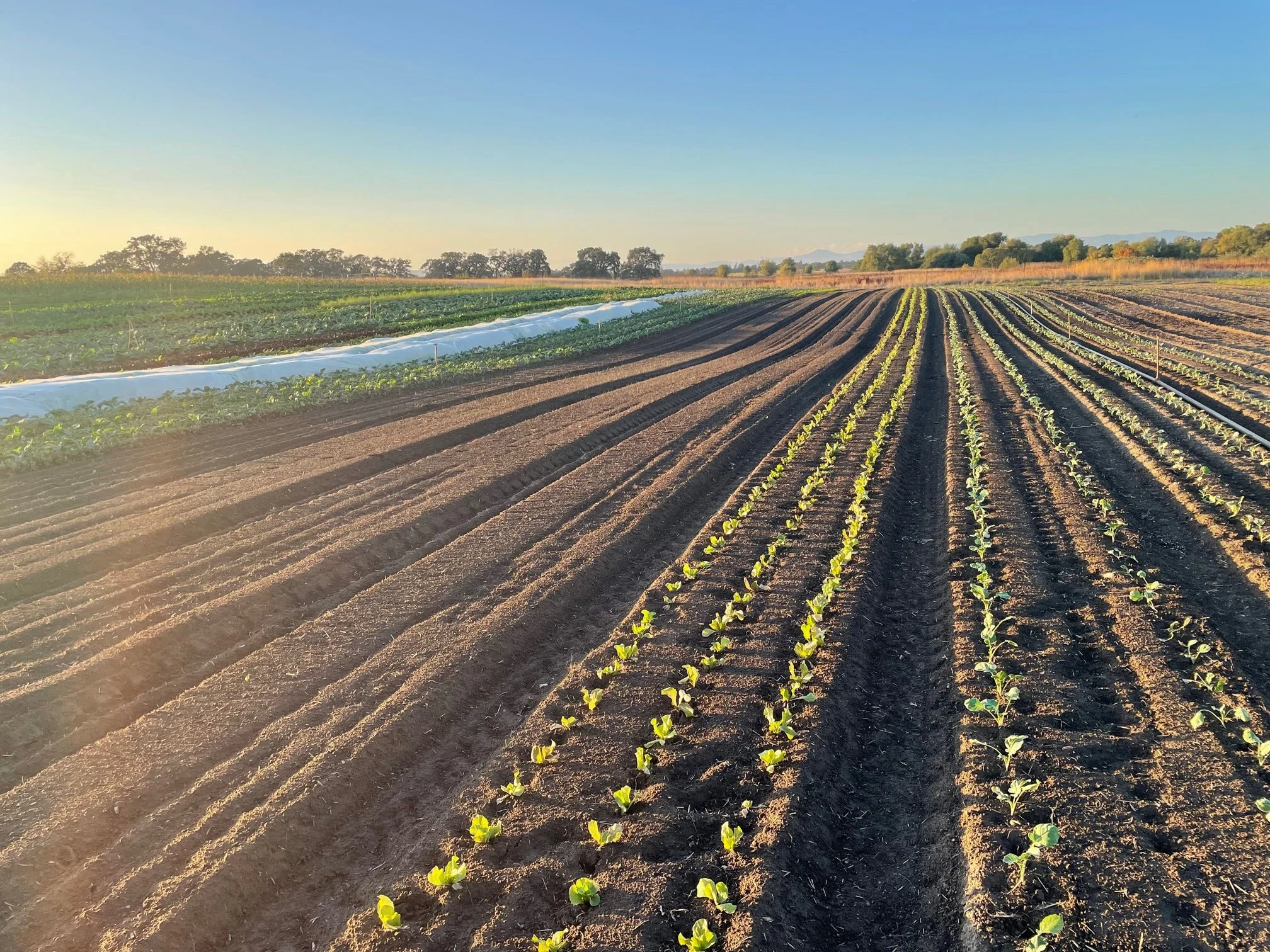THIS WEEK'S HARVEST
Heirloom & Slicing Tomatoes (See Week 9’s newsletter for variety descriptions), Jimmy Nardello & Bell Type Sweet Peppers, Eggplant, Walla Walla Sweet Onions, Italian Late Softneck Garlic, Cabbage, Siberian Kale, Rainbow Chard, Easter Egg Radishes, Striped Armenian Cucumbers, Olympian Cucumbers, Summer Squash and Zucchini, Rainbow Carrots, Sarah’s Choice Cantaloupe Melons, Spicy Mustard Mix, Little Gems and Mixed Head Lettuce
U-PICK
🌟Dragon Tongue Green Beans: See below for tips
Strawberries
Husk Cherries See week 8’s newsletter for harvest tips
Cherry Tomatoes: No limit this week! See week 7’s newsletter for varieties
Frying Peppers: Shishito, Black Hungarian, Padrón / See Week 2's newsletter for harvest tips
Jalapeños: Located below the frying peppers
Herbs: Italian Basil, Tulsi Basil, Thai Basil, Purple Basil, Italian Parsley, Rosemary, Lemon balm, Lemon Verbena, Perennial Cilantro, Annual Cilantro, French Sorrel, Onion Chives, Garlic Chives, Shiso, Tarragon, Oregano, Thyme, Chamomile, Mints, Dill, Anise Hyssop (*New Italian, Thai, and Purple basil plantings on the west side of the garden.)
Flowers!
NEW CROP NOTES
Walla Walla Sweet Onions: A delicate, sweet, fresh-eating onion developed in Walla Walla Washington. These are a delicacy. Try them in a way that you can show them off: Lightly grilled in a good burger or raw in a salad with a delicate dressing. They are so mild, some people even eat them raw like an apple! (We haven’t tried it, let us know how it goes!) Read more about Walla Wallas here.
Dragon Tongue Green Beans: These are juicy, cream colored heirloom green beans with purple stripes. Eat them raw or cooked. They are located on the farm in the field to your left if you’re standing at the head of the cherry tomato beds. Please be extra careful (especially with kiddos) not to step on the beds next to them where we have growing leeks and fresh planted chicories.
Jimmy Nardello Peppers: We’ve had these out a couple times, these are the long, thin peppers that look like hot cayennes. They’re not, they’re exceptionally sweet beauties. Our favorite pepper for eating raw or cooking.
PRESERVE TOMATOES
Pick-up your tomatoes for canning or preserving this week before they are gone! Each share may take a 15 lb (season limit) batch of tomatoes from the back table. You can take your 15 lb allotment all at once, or in smaller increments (7lbs this week, 8 lbs next week, for example). But get them now, because the late summer avalanche is almost over!
We’ll have a scale out for weighing. Please bring your own bag or box to take them home.
Preserving tomatoes… the easy way: A really yummy way of preserving tomatoes (sauce tomatoes, or heirlooms) that is slightly less involved than canning is… Halve the tomatoes and spread them on a baking sheet. Pour a little olive oil over them, and throw in some garlic and onions. Roast this concoction on on a low temperature until the water is reduced and the flavor concentrated. Take out of the oven and let cool. Put the saucy mixture into pint jars or bags and store them in the freezer for future use!
PESTO BASIL
Each share may take home two whole basil plants from the old planting. Just snip the plant at the base. (Make sure you’re in the old planting which has a white stake in it with a red flag.
BRAMBLE TAIL MILK HERDSHARE
As many of you know, this land is home to Bramble Tale Homestead, a grass fed raw milk herdshare and a true Sonoma County local food gem.
Raw milk — from healthy cows raised on grass — is a nutrient-dense and alive food, containing active nutrients, healthy fat & protein, immune factors, vitamins, minerals, enzymes & healthy bacteria. The Jersey cows are rotationally grazed through the grasslands of this diversified and collectively owned land, playing a vital role in the regeneration of the landscape by sequestering carbon & creating habitat for wildlife while feeding our community.
Their herdshare program works similarly to our CSA where member-owners of the herd receive a portion of the milk produced by the herd each week. They also offer a value-add share (think yogurt, feta, and fresh cheese!)
It’s an incredible experience, trust us, we’ve been members for 5 years!
For more information email Aubrie and Scott: brambletailhomestead@gmail.com
VOLUNTEER WEDNESDAYS, 8:00-10:00 AM
Interested in some farm therapy? Come out on Wednesday mornings to help us tend the garden and farm together! Find us in the garden or out in the main fields on Wednesdays from 8:00am 'til 10:00 am. People of all abilities welcome, we’ll find something comfortable for you to do!
FARMER’S LOG
The Peace of Wild Things
by Wendell Berry
When despair for the world grows in me
and I wake in the night at the least sound
in fear of what my life and my children’s lives may be,
I go and lie down where the wood drake
rests in his beauty on the water, and the great heron feeds.
I come into the peace of wild things
who do not tax their lives with forethought
of grief. I come into the presence of still water.
And I feel above me the day-blind stars
waiting with their light. For a time
I rest in the grace of the world, and am free.
See you in the fields,
David & Kayta
Illustrations by Kayta from the Heart of Tracking by Richard Vacha from Mount Vision Press















